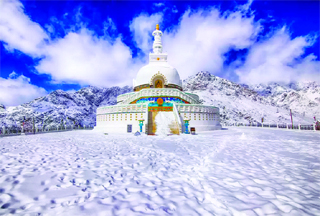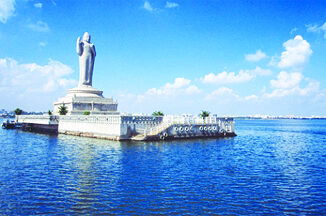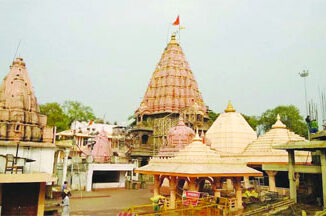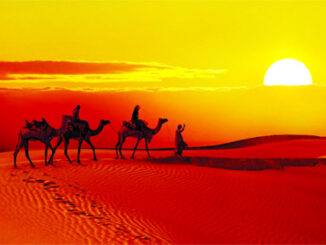
The Land of High Passes, Ladakh, the newly created Union Territory in India (previously a part of Jammu & Kashmir), boasts a landscape that can leave you with your jaws dropped. It is a place where the landscape changes dramatically; it is truly astonishing to see the mountains, snow, cold desert, alpine meadows and lakes at a short distance from each other. Tourism in Ladakh is an absolute delight for nature lovers as well as adventurers.
Adorned with the lofty barren mountains, Ladakh is home to some of the highest motorable passes like Khardung La (5359 m), Marsimik La (5582 m), and Chang La (5360 m), and alpine lakes like Pangong Tso (4350 m) and Tso Moriri (4522 m). Ladakh is further divided into three regions – Leh, Nubra, and Zanskar, and each region has several places to see.
Ladakh is majorly popular amongst the adventurers who feel welcomed by the number of adrenaline rushing activities offered here. The union territory is amongst the top trekking destinations in India with amazing and unmatched treks like the popular Frozen River Trek/Chadar Trek. Ladakh also has opportunities for mountaineering, motor biking, mountain biking, white water rafting and more.
A lot of volunteering options are also available for those who have the leisure of time and would like to contribute to the cause of not just conservation but also social upliftment by contributing to the development efforts in the region. Camel safari in the sand dunes of Hunder is another surreal experience, perfect for a family trip. All this if you can take a break from gaping at the larger than life landscapes here!
STOK KANGRI
Stok Kangri is the highest mountain peak in the Stok range of the Himalayas. At 20,500 ft, it is also the highest trekkable summit in India. It has always been a great lure for trekkers from all over the world and is quite popular since it requires relatively less trekking skills. Ideally done between 6-10 days, it is one of the must have Ladakh experiences.
You need to be properly acclimatised to the high altitude conditions before attempting this one. It is advisable to make a summit attempt if you have prior experience of scaling some 14,000 ft peaks. A lot of mental fitness also goes into this one, for weather can take sudden turns on the trek to Stok Kangri. Still, it is a must do if adventure is your calling and you harbour a secret wish to scale a world-famous Indian peak.
BIKING
This one is for the more ardent adventurers. Leh Ladakh offer one of the toughest terrains and the most alluring landscapes in the world, making the region perfect for biking expeditions. You can rent a bicycle (at INR 300-500 per cycle per day) or a motorbike (at INR 800-1600 per bike per day) from one of the rental points in Leh and explore the region at your pace. Though Khardung (17,582 ft), one of the highest motorable passes in the world, is right at the top of bikers’ favourite list, there is a lot more. You can join an expedition or go solo on some of the most awe-inducing stretches that include Leh-Pangong Tso, Leh-Nubra Valley, Leh-Alchi, Leh-Tso Moriri and Leh-Hunder. Time to set some new records.
PHOTOGRAPHY
Leh and Ladakh are such great loves of photographers that you will see hordes of them, trekking in high-altitude zones, lugging their bulky camera equipment with them. If you, too, share their love or harbour a wish to shoot some fascinating photos or time-lapse videos, get ready to be enthralled. Some of the best vantage points for photography in Leh and Ladakh are the Shanti Stupa, Leh Palace, the sand dunes of Hunder, Stakna Monastery, Diskit Monastery, Chang La, Khardung La, Pangong Tso and Tso Moriri, which offers some fascinating views of the Changthang region. Changpas and Ladakhis of course make for some of the best portraits that you can capture. Their bright smiles might just be too hard to catch with a camera though.
CAMEL SAFARI AT HUNDER
Hopping on for a ride on the Bactrian camels and exploring the sand dunes at Hunder is another must do in Ladakh. These camels are one of the few reminders of the Silk Route days, when Hunder was a major business port. With most of the camels domesticated now, you can approach the village people to arrange a ride for you. These safaris can extend from hours to days, depending on your choice. Sunsets are the best time to go on the safari, for the dunes turn golden under the setting Sun.
Must see
The Leh Palace, which is situated behind the main market has eight stories and is similar to the Potala Palace of Lhasa and still belongs to the royal family of Ladakh. Just ahead of the palace is the famous Chamba Temple, which is a oneroomed shrine that has a huge icon of Maitreya, the Buddha to come. Since this temple cannot be found easily, it is essential to enquire about it in the second row of shops. Also in the bazaar, at the top of the street, one can see the Jama Masjid. This has been painted in green and white colour. Another place that you must visit is the Sankar Gompa, which is situated within the city and is one of the oldest structures here. At one time, this monastery only welcomes maximum twenty monks and is a fairly active one. Also the monks here are extremely hospitable and always offer yak butter tea to those visiting the monastery.
Also a visit to the famous Thikse Monastery is a must. This monastery is the largest such structure in central Ladakh and is primarily known for its magnanimous statue of Maitreya (future Buddha) in its Maitreya Temple. This statue is 15 meters (49 ft) high and the largest such statue in Ladakh. The Buddha here is unusually portrayed as seated in the lotus position rather than his usual representations as standing or in a sitting posture on a high throne.





Be the first to comment